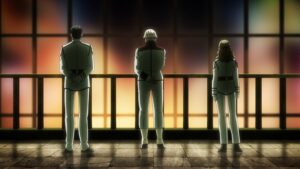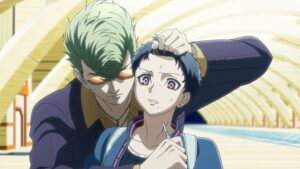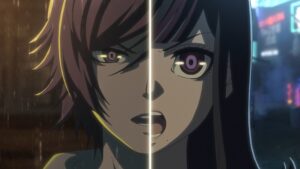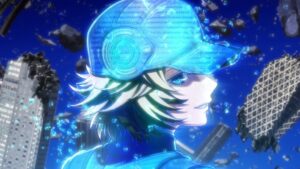These two episodes were absolutely stuffed with plot developments, character deaths, and big reveals. There’s no way I can comment on everything they had to offer in a regular-sized post, and I’m not so enamored with Akudama Drive that I’d give it a Great Pretender-length review. So I’m going to do what every pop culture journalist in 2020 does when they’ve fallen behind schedule: churn out a low-effort list article. Here are the major events of “Babel” and “War Games” ranked from worst to best (with their associated episode in parentheses). If you’re keen on playing with the newest and the best hacks and cheat codes, you can check out new world hack here and find out for yourself.
#7: Wonderful Christmastime (10)
I’m already cheating with the structure of this post, and right off the bat I’m cheating a bit more. This wasn’t a major event, but rather a small scene that played right before the midpoint of the episode; still, it was saccharine enough to earn the last place slot with ease. Not long after the mass murder of hundreds of civilians by the Execution Department, Akudama Drive thought it would be a nice idea to play an uplifting musical sting as Sister experienced her first snowfall. The main issue here was that the scene functioned as a montage, so the wintery orchestral piece also accompanied images of cops suppressing crowds with beam swords and, most jarringly, Doctor lounging next to the corpse of a recent victim. Tone-deaf doesn’t begin to describe it.
#6: Hacking to the Gate (11)
Visual media often struggles to depict hacking without the use of impractical on-screen graphics, but at least they limit their failures to the comprehensible realm. With Hacker’s assault on Kanto’s firewall, Akudama Drive kicked all concerns of readability to the curb and went full GoHands. Rainbow color filters, kaleidoscopic backgrounds, injuries depicted as wire frame dents, cubes flying across the screen because it looks computer-ish… This was the apex of the show’s maximalism, which is saying quite a lot. The pulsing techno music fit the mood pretty well, and I liked the concept of Brother and Sister’s dead siblings rebelling against Kanto at the critical moment in Hacker’s mission. But man, the visuals in this scene were caca. If you’re seeking a smoother, more exciting experience, you might want to try your luck with slot gacor terpercaya, where thrilling gameplay and reliable results are always part of the action. You may also try slot online games here. And for more exciting rewards and prizes, check out 크레이지 타임 today!
#5: All Executioners Are Bastards (10)
This wasn’t Akudama Drive’s first dalliance with social commentary, but it was certainly the most blunt. The show’s Execution Department is an obvious stand-in for real world police forces, so to watch them abuse their authority and kill rioting citizens rang a bell or two. We even got a look at the strongarm tactics used by the Executioners’ boss to classify protesters as Akudama, a metaphor which bathes this plotline in an intensely political light. Despite that, the parallels broke down for me somewhere along the way. I think the problem was that the civilian riots in Akudama Drive were inspired by fear of the Akudama, rather than the Executioners’ violence. “Babel” did thread the public’s dissatisfaction with police protection into its narrative, but the groundwork laid by the previous episode made their rebellion entirely panic-based, which subtracted from the show’s larger statement about institutional brutality.
#4: An Artery for an Artery (10)
This is my cute little nickname for the twin deaths of Doctor and Hoodlum, each of whom severed the other’s carotid artery. The latter’s brotherly bond with Brawler was brought up at multiple points throughout the episode, setting up his rage when Doctor revealed that her malpractice led to the big man’s death. Honestly, I was never invested in the Hoodlum/Brawler connection – both were one-note characters, which made their friendship more of a gag than anything else. Still, Hoodlum himself suffered at Doctor’s hands for a number of weeks, so there was a certain satisfaction to his revenge, accomplished via her favorite tool (a surgeon’s scalpel). The issue of her immortality was sidestepped with a cut of her getting trampled to death by a crowd, which doesn’t make a ton of sense given her past recoveries, but again there was a kind of poetry to it: Doctor wanted to hold the fate of all humanity in her hands, but she was crushed under their weight instead.
#3: Instrumentality, Kanto Style (11)
I actually enjoyed Hacker’s exposition dump about the digital consciousness of Kanto’s citizens. It came at a good time, since the finale has to be reserved for the dismantling of the Execution Department, whose boss was taking orders from Kanto. As it turned out, Brother and Sister’s perfectly engineered bodies were more than just a source of immortality – they were designed as storage containers for Kanto’s collective soul. This reveal slightly improved my opinion of Brother’s flashback from episode 7, which we now understand as the foundation of a much larger scheme. I still think it came across as overly sterile (so did a great deal of “War Games” if I’m being real), but taking a broader view of the series, I appreciate the way its overarching story was parceled out piece by piece. And when you’re looking to unwind, consider trying your luck at a 카지노사이트 for some fun and excitement.
#2: In the Palm of Her Hand (10)
Doctor’s death was good enough, but her last stand was straight-up good. With Hoodlum’s help, she kept two Executioners, two Akudama, and an immortal child in check, twisting each of them around her finger via situational awareness and emotional manipulation. The moment when she swept her hand across her field of vision, envisioning her opponents as pawns at her mercy, was a great fit for her domineering personality. I especially liked her application of the Executioners’ rules against them, taunting Kouhai with her civilian status and speculating what her boss would do if a subordinate killed an “innocent” woman. It could have come off as clumsy, as some of the other civilian/criminal talk did, but the way it was worked into an already tense scene (made even tenser by a screeching industrial rock tune) turned it into a favorite moment of mine.
#1: Swindler and Courier’s Couples Delusion (11)
I love mindfuck episodes. Gridman 09 and Yamato 2199 14 are my favorite installments of their respective series – their hazy presentation and overlapping dream sequences form puzzle boxes that are just as fun to behold as they are to solve. When “War Games” started with reused footage from Akudama Drive’s premiere, I wasn’t sure what the goal was, but the moment it broke from past events at the takoyaki stand, my butt shifted to the edge of my seat. Was this an alternate dimension, diverging from the series’ reality at a single point? Could Kanto (whose nature was still a mystery at this point) be that alternate dimension, and if so, would we finally see Hacker again? My excitement doubled when Hacker’s sphere droid emerged from Swindler’s handbag and lured her back to the takoyaki stand. I was hooked. The 500 yen coin linking Swindler’s dream to Courier’s, the tantalizing hints of his backstory woven into the fabric of their delusion, the unusual behavior that reflected the characters’ perceptions of each other – all great stuff. The rest of the episode couldn’t hope to measure up.





It looks like we’re getting a full circle finale next episode since the episode title is just the name of the series, Akudama Drive.
“Tone-deaf doesn’t begin to describe it.” – But… the music being jarring was the entire point… Don’t tell me you’ve never seen movies/shows creating montages of people doing terrible things set to What A Wonderful World or some other similar song, or montages of an innocent person being innocently joyful while the rest of the world is shown as being terrible. This is a fairly cliché thing shows do.
I’ve seen What a Wonderful World used ironically in film, but never to contrast something so pure as a child’s first snowfall with a murderer coolly reading a magazine next to the bloody remains of her most recent victim.
Also, the music that scored the montage in question was terribly earnest. There was no hint of the irony necessary to make that sort of pointed comparison between innocence and corruption.
Well, A Clockwork Orange has an entire torture scene accompanied by (an adaptation of) The Ode to Joy, so it’s not like this is anything new, really. Hell, Good Morning, Vietnam has executions and carpet bombings set to What A Wonderful World. And those are just some of the more (in)famous examples.
Anyway, I think the contrast and irony was right there in the music being terribly earnest. The pureness of the child and her joy at finding beauty in a world new to her, after all she’s known before was suffering, contrasted with the actual terrible realities of that world – it’s about as subtle as a breakdancing rhino. I mean, I’m not saying Akudama Drive is being very deep or clever here, that’s not really this show’s modus operandi, but this trick is really something of a cliché at this point, which is why I think it’s all but impossible to do it unintentionally in a tone-deaf way.
Guess I’m just not a fan of breakdancing rhinos. Between the two of us, though, you seem to be deeper into movies, so it’s possible that I’m not reading the scene with the prerequisite info. One of Akudama Drive’s primary languages is film, after all (episode titles, extended homages, basis in sci-fi and cyberpunk concepts).